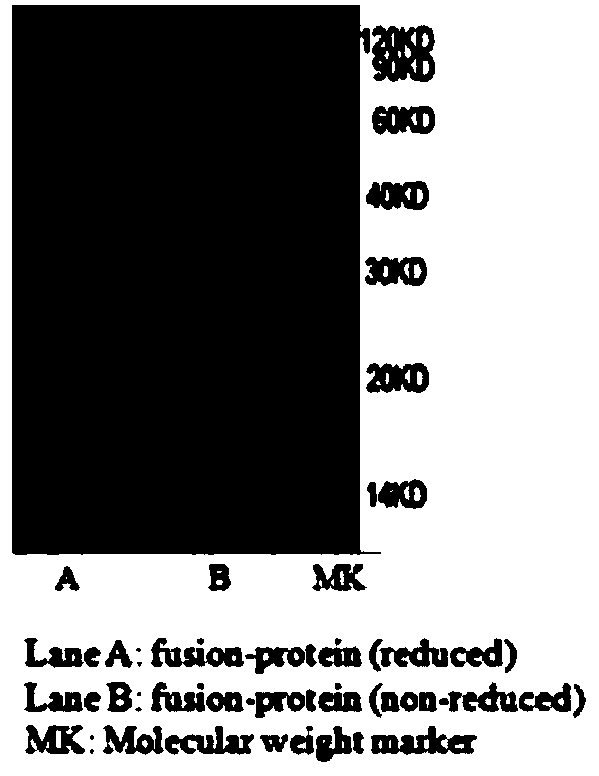A fusion protein and its application for restoring the function of exhausted immune cells
A technology of immune cells and fusion proteins, applied in the field of fusion proteins, can solve the problems of specific cells that cannot be targeted at exhaustion, achieve good clinical prospects, wide application range, and enhance the effect of controlling viral infection
- Summary
- Abstract
- Description
- Claims
- Application Information
AI Technical Summary
Problems solved by technology
Method used
Image
Examples
Embodiment 1
[0043] This example is the gene construction and production purification of the recombinant fusion protein.
[0044] According to the amino acid sequence of the C-terminal of the human PD-1 antibody heavy chain (SEQ ID NO: 6) and the N-terminal of interleukin 2 (SEQ ID NO: 14), through gene synthesis, enzyme digestion and further cloning, the two parts were passed through 17 non- Functional amino acids (SGGGGSGGGGSGGGGSG) were connected to form the fusion protein heavy chain construct gene (SEQ ID NO: 23), and then transferred into the eukaryotic expression vector pcDNA3.1. Through gene synthesis, enzyme digestion and further cloning, the light chain (SEQ ID NO: 7) gene of the PD-1 antibody was transferred into the eukaryotic expression vector pcDNA3.1. Finally, the heavy chain expression vector and light chain expression vector of the fusion protein were simultaneously transfected into Chinese hamster ovary cells (CHO). Transfected cells were placed at 37°C, 5% CO 2 Culture...
Embodiment 2
[0046] This example is the activity and function determination of the bifunctional recombinant fusion protein on human PBMC cells cultured in vitro.
[0047] Human peripheral blood was isolated and purified by lymphocyte density gradient centrifugation (Ficoll), and the cell density was diluted to 5×10 in X-Vivo15 medium in a 24-well plate. 6 / ml, add the test protein to a final concentration of 2 μg / ml. Incubate at 37°C for 30 minutes, replace the X-Vivo15 medium after centrifugation, until the final cell density is 5x10 5 / ml. Then placed at 37°C, 5% CO 2 After being cultured in the incubator for 72 hours, the cells were collected and stained with CD8 and PD-1 antibodies, and flow cytometry was used for phenotypic determination and data analysis. figure 2 Shown in , with unfused PD-1 antibody ( figure 2 Part 2 of ) and interleukin 2 ( figure 2 Part 3 of ) compared to fusion protein treatment ( figure 2 Part 1 of ) can significantly increase the proportion of CD8+ c...
Embodiment 3
[0049] This example is the effect of the bifunctional recombinant fusion protein on effector cells in vivo.
[0050] Black mice were injected with fusion protein (4 μg / mouse / day) or interleukin 2 (40 μg / mouse / day) or PBS (control group) through the abdominal cavity for 3 consecutive days, and peripheral blood was collected from the tail on the 4th day, and treated with anti-mouse CD8 and NK1.1 flow cytometry antibody staining detection, data analysis such as Figure 4 . with the control group ( Figure 4 Part 1, 4.0%) and interleukin 2 group ( Figure 4 Compared with the second part of , 15.3%), the recombinant fusion protein significantly increased the proportion of NK cells in lymphocytes ( Figure 4 Part 3, 27.0%). At the same time, in the part of CD8+T cells, compared with the control group ( Figure 4 Part 1 of , 15.5%), native interleukin 2 did not increase the proportion of CD8+ cells ( Figure 4 Part 2 of the fusion protein, 15.1%), while the proportion of CD8+T ...
PUM
 Login to View More
Login to View More Abstract
Description
Claims
Application Information
 Login to View More
Login to View More - R&D
- Intellectual Property
- Life Sciences
- Materials
- Tech Scout
- Unparalleled Data Quality
- Higher Quality Content
- 60% Fewer Hallucinations
Browse by: Latest US Patents, China's latest patents, Technical Efficacy Thesaurus, Application Domain, Technology Topic, Popular Technical Reports.
© 2025 PatSnap. All rights reserved.Legal|Privacy policy|Modern Slavery Act Transparency Statement|Sitemap|About US| Contact US: help@patsnap.com



